10 Best Places to Visit in Turkey
Key Takeaways
- Turkey offers a wide range of captivating destinations including Istanbul, Cappadocia, Ephesus, and the Turquoise Coast.
- Topkapi Palace is a historical masterpiece showcasing Ottoman opulence and treasures.
- Hagia Sophia, originally a Byzantine Cathedral and later a mosque, features stunning architecture and mosaics.
- Basilica Cistern and Galata Tower, along with Cappadocia Fairy Chimney, add to Turkey’s rich historical and architectural heritage.
Turkey offers a treasure trove of diverse and captivating destinations for travelers. Istanbul, straddling Europe and Asia, is an appealing metropolis where the ancient and modern coexist, with iconic landmarks like the Hagia Sophia and the Blue Mosque.
Cappadocia’s surreal landscapes are a must-see, with its unique rock formations and hot air balloon rides. The ancient city of Ephesus is a remarkable archaeological site, while Pamukkale’s terraces of mineral-rich thermal waters are a natural wonder.
The stunning Turquoise Coast, with places like Antalya and Bodrum, boasts pristine beaches and historical sites. Göreme National Park, a UNESCO World Heritage Site, is a haven for hikers and history buffs.
For tranquility, visit the fairy-tale-like town of Şirince, or immerse yourself in Turkish culture in Gaziantep, famed for its cuisine. And lastly, explore the remote and striking landscapes of Mount Ararat, Turkey’s highest peak.
These ten destinations showcase the city’s rich history, natural beauty, and warm hospitality, making it a must-visit country for any traveler.
Topkapi Palace
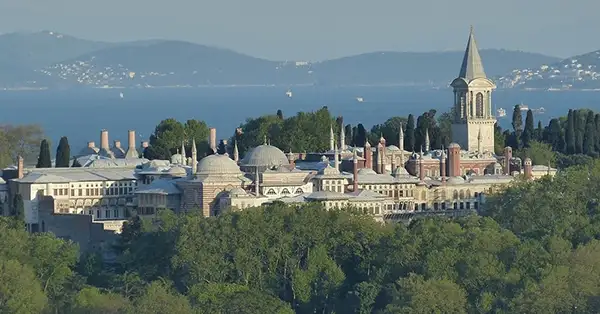
Topkapi Palace, a historic gem in the heart of Istanbul, stands as a well-defined testament to the grandeur of the Ottoman Empire. This magnificent palace complex, situated on the Seraglio Point overlooking the Bosphorus Strait, served as the primary residence and administrative center of Ottoman sultans for nearly four centuries.
Its construction began in the 15th century under Sultan Mehmed the Conqueror and continued to expand with each successive ruler. The palace is divided into four main courtyards, each with its own distinct purpose.
The Harem, an intriguing section, housed the sultan’s family and concubines, offering a glimpse into the private lives of the royals.
The palace also showcases a dazzling array of jewels, artifacts, and precious items, including the legendary Topkapi Dagger and the Spoonmaker’s Diamond.
Topkapi Palace is an architectural masterpiece, featuring intricate tilework, lush courtyards, and an array of ornate chambers and pavilions.Topkapi Palace entrance fee ranges from 100 Turkish Lira to 150 Turkish Lira.
While the specifics of the entrance fee can vary based on factors such as age, nationality, and access to specific sections, it serves as a modest investment to unlock the treasures held within the palace’s walls.
Hagia Sophia
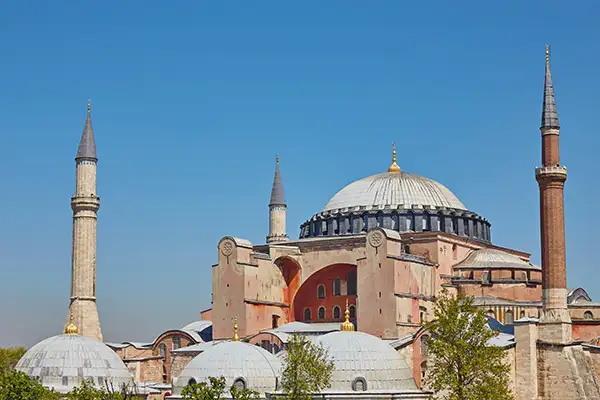
Hagia Sophia, known as Ayasofya in Turkish, is an architectural masterpiece and a symbol of Istanbul’s complex history. It was originally constructed as a cathedral in 537 AD during the Byzantine era and served as the spiritual center of Eastern Orthodox Christianity for nearly a millennium.
Its grand dome and incredible mosaics were considered marvels of engineering and artistry in their time. In 1453, when the Ottoman Empire conquered Constantinople (modern-day Istanbul), Hagia Sophia was converted into a mosque, a role it served for nearly 500 years.
The Ottomans added minarets and Islamic features while preserving the glory of the original structure. From the grand dome to the intricate mosaics, each sight within the Hagia Sophia tells a story that resonates with the echoes of the past.
The Hagia Sophia ticket prices range from affordable rates to premium options. Plan your visit and discover the architectural marvels, captivating mosaics, and rich history of this iconic landmark. Immerse yourself in the beauty and grandeur of Hagia Sophia with a ticket that suits your preferences and budget.
Lake Cildir

Lake Cildir, or Çıldır Gölü in Turkish, is a natural wonder situated in the eastern part of Turkey, near the border with Georgia. This high-altitude lake is renowned for its striking beauty, peaceful surroundings, and unique characteristics that set it apart from other bodies of water in the region.
One of its most distinctive features is its remarkable size, making it the largest freshwater lake in eastern Anatolia. Stretching over an expansive area, it offers plenty of room for various recreational activities and opportunities for exploration.
The lake is known for its crystal-clear waters, which are fed by numerous freshwater springs and small rivers, creating an ecosystem rich in biodiversity. It is also famous for its frigid temperatures during the winter months.
In fact, it often freezes entirely, transforming into a vast, pristine ice rink that allures both local and international visitors.
This unique phenomenon allows for ice skating, ice fishing, and even horse-drawn sleigh rides on the frozen surface, offering an extraordinary experience for those willing to brave the cold.
Ishak Pasha Palace
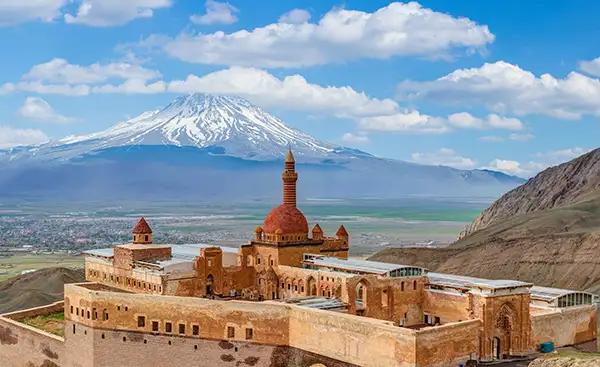
The Ishak Pasha Palace, located in the far eastern part of Turkey near the town of Dogubeyazit, is a breathtaking monument that reflects the rich architectural and cultural heritage of the region.
It is often described as a “dream on the Silk Road,” and is a testament to the opulence of the Ottoman Empire and the convergence of various architectural styles.
Constructed over a period of about 100 years, starting in the late 17th century and continuing into the 18th century, it showcases an amalgamation of architectural influences, including Seljuk, Ottoman, Persian, and Armenian. Its complex layout comprises courtyards, halls, living quarters, and mosques, all intricately designed with exquisite detail.
The palace is famous for its ornate decorations, delicate carvings, and stunning frescoes, which adorn the interiors. Its unique features include a beautifully crafted mosque, a grand audience hall, and a harem section, providing a glimpse into the life of the elite during the Ottoman era.
Perched on a hill overlooking the picturesque landscape of the region, it offers breathtaking views of Mount Ararat and the surrounding mountains, creating a dramatic and awe-inspiring backdrop.
The Kackar Mountains
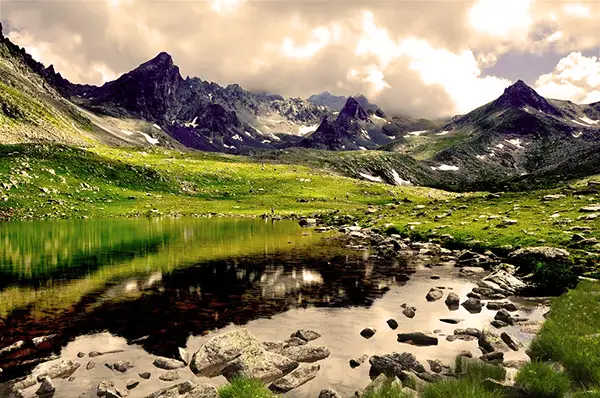
The Kaçkar Mountains, or Kaçkarlar in Turkish, form one of the city’s most astonishing and rugged mountain ranges. These mountains are located in the northeastern part of the country, near the border with Georgia, and are perfect for outdoor enthusiasts and nature lovers.
They are characterized by their pristine wilderness, dramatic landscapes, and towering peaks.
The region is also home to numerous other challenging summits, offering ample opportunities for mountaineering and trekking adventures. One of its defining features is its lush alpine meadows and dense forests.
The region is blanketed with several varieties of flora and fauna, including endemic plant species and diverse wildlife such as brown bears, wolves, and eagles. This ecological diversity has earned them recognition as a protected national park.
Do You Know?
The highest point in this range soars to an elevation of approximately 3,937 meters (12,917 feet), making it Turkey’s highest peak outside of eastern Anatolia.
The Uludag Mountains

The Uludağ Mountains, often referred to simply as Uludağ, are a majestic mountain range located in northwestern Turkey, near the city of Bursa. Popular for its scenic beauty, rich history, and outdoor recreational opportunities, it has been a cherished destination for nature enthusiasts and adventure seekers for centuries.
The highest peak in the Uludağ range, also named Uludağ, stands proudly at an elevation of approximately 2,543 meters (8,343 feet) above sea level.
During the winter months, it transforms into a winter wonderland, attracting skiers and snowboarders to its well-developed ski resorts.
These resorts offer numerous winter sports activities, from downhill skiing to snowshoeing, and provide breathtaking views of the surrounding landscape blanketed in snow.
In the warmer seasons, it offers a plethora of hiking and trekking opportunities. Dense forests, lush meadows, and cascading waterfalls provide a picturesque backdrop for outdoor adventures.
Visitors can explore various hiking trails that cater to different skill levels, allowing them to immerse themselves in the natural beauty of the region.
Aladaglar National Park

Aladaglar National Park, located in southern Turkey’s Taurus Mountains, is a pristine natural wonderland known for its rugged landscapes, soaring peaks, and rich biodiversity. This protected area, established in 1995, encompasses approximately 1,000 square kilometers of stunning terrain, making it one of the city’s most celebrated national parks.
Its most distinguishing feature is its dramatic limestone mountains, which reach heights of over 3,000 meters (9,800 feet). These towering peaks are a haven for mountaineers and rock climbers, offering challenging ascents and numerous climbing routes of varying difficulty levels.
The park’s stunning rock formations and steep cliffs create a mesmerizing backdrop for outdoor enthusiasts. It is also home to a wide array of flora and fauna. The lush valleys and alpine meadows are adorned with colorful wildflowers in the spring and summer, while the dense forests provide habitat for diverse wildlife, including wild goats, bears, and numerous bird species.
The park’s pristine rivers and streams add to its ecological richness.
Basilica Cistern
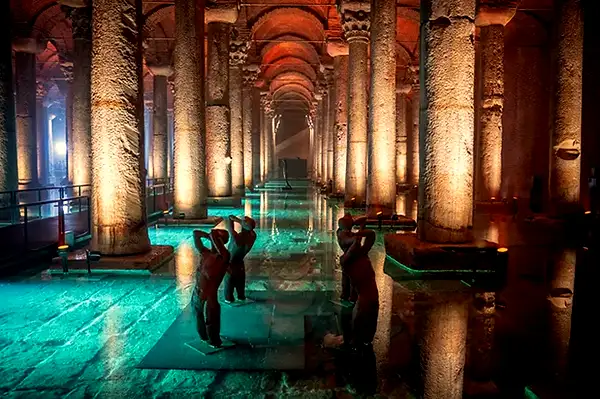
The Basilica Cistern, known as the “Yerebatan Sarnıcı” in Turkish, is a mesmerizing underground wonder located in the heart of Istanbul, Turkey. This ancient cistern, constructed during the reign of Emperor Justinian I in the 6th century, is a remarkable testament to Byzantine engineering and architecture.
The cistern was designed to store and supply water to the Great Palace and other buildings of Constantinople, the capital of the Byzantine Empire. Its vast underground chambers are supported by an impressive forest of 336 marble columns, each standing approximately 9 meters (30 feet) tall.
The cistern’s mystical ambiance is enhanced by dim lighting and its serene, reflective waters, which shimmer with the ancient history contained within its depths.
Visitors are captivated by the meditative atmosphere as they stroll along raised walkways and admire the intricately carved columns, many of which feature unique designs, such as Medusa heads and inverted columns reused from earlier structures.
Interesting Fact
The Basilica Cistern derives its name from the Basilica of St. Sophia (Hagia Sophia), which once stood on the same site.
Galata Tower
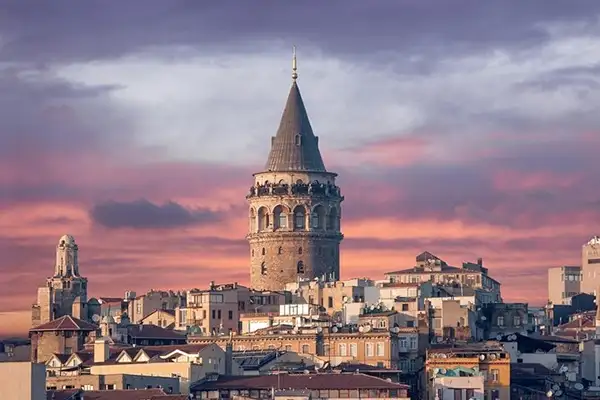
The Galata Tower, known as the “Galata Kulesi” in Turkish, is an iconic landmark that graces the skyline of Istanbul, Turkey. Standing tall and dignified in the heart of the historic Galata district, this medieval tower is a symbol of the city’s rich history and architectural legacy.
Constructed in the 14th century by the Genoese, it has served various purposes over the centuries. Initially built as a defensive fortification to protect the Genoese colony of Galata, it later functioned as an observation tower, fire lookout, and even a prison during different periods of its history.
The tower’s architecture is a fine example of medieval masonry and design and is marked by its distinctive cylindrical shape and stone exterior.
Its conical roof and prominent balconies add to its unique charm, and the interior has been renovated to house a restaurant and a popular observation deck offering panoramic views of Istanbul.
Visitors who ascend the Galata Tower are rewarded with spectacular vistas of the historic peninsula, including iconic landmarks such as the Hagia Sophia, Blue Mosque, and Topkapi Palace, as well as the shimmering waters of the Bosphorus Strait and the Golden Horn.
Fairy Chimneys

Fairy chimneys are a geological marvel found in several regions of the world, but they are most famously associated with the Cappadocia region in central Turkey.
These extraordinary rock formations, also known as “hoodoos” or “earth pyramids,” are the result of millions of years of natural processes and have become an iconic symbol of Cappadocia’s surreal landscape.
They are characterized by their whimsical, towering shapes, which resemble something out of a fairy tale. They are formed from volcanic tuff, a type of soft rock that was deposited by volcanic eruptions millions of years ago.
Over time, wind and water erosion sculpted the tuff into its distinctive mushroom-like forms, often featuring a harder capstone on top that protects the underlying cone from further erosion. In Cappadocia, these unique rock formations served as more than just natural wonders.
Throughout history, people have carved homes, churches, and entire underground cities into fairy chimneys. Cappadocia’s ancient residents used these naturally insulated structures as shelters, creating intricate networks of tunnels and chambers beneath the surface.









